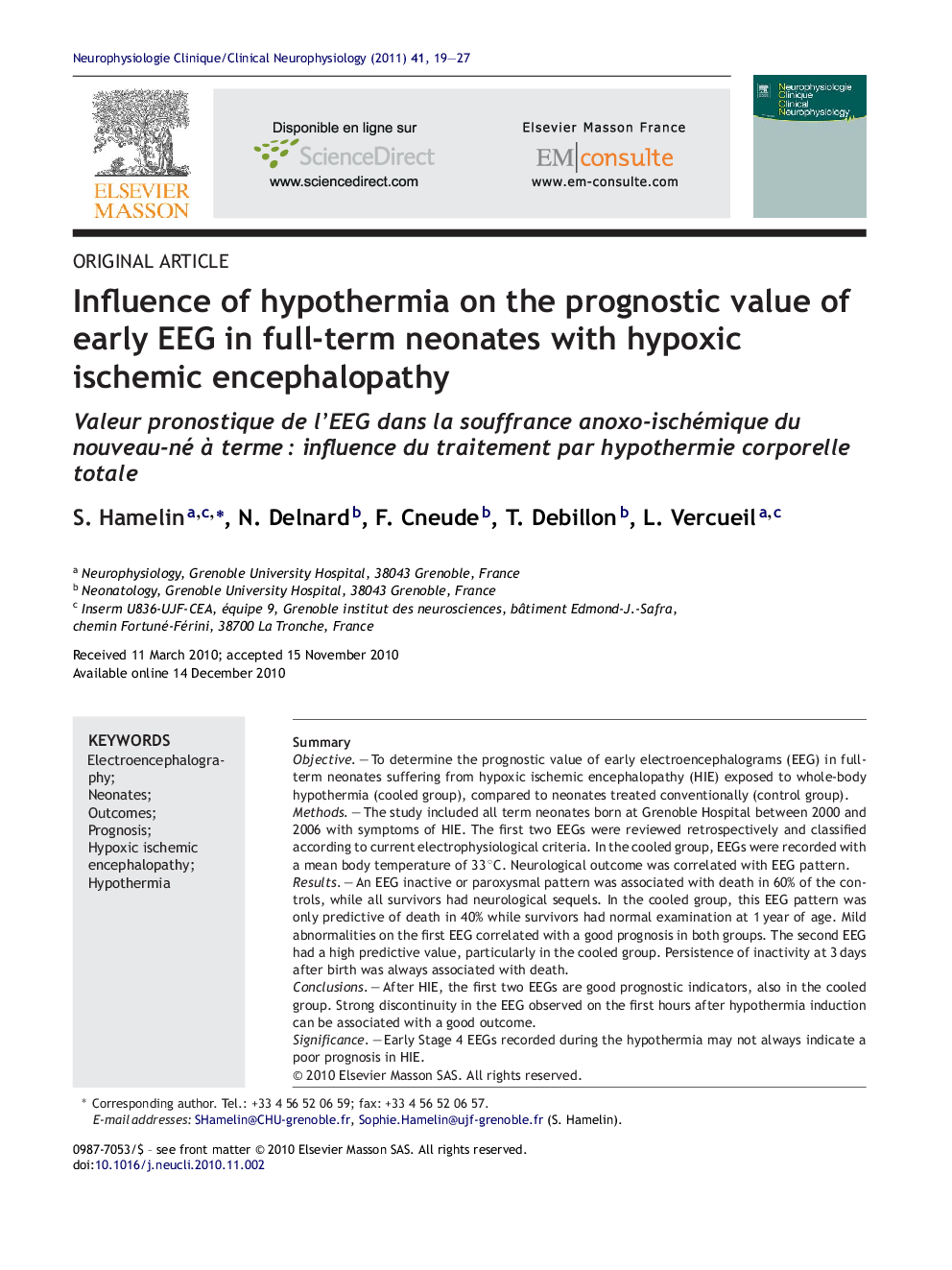| Article ID | Journal | Published Year | Pages | File Type |
|---|---|---|---|---|
| 3082721 | Neurophysiologie Clinique/Clinical Neurophysiology | 2011 | 9 Pages |
SummaryObjectiveTo determine the prognostic value of early electroencephalograms (EEG) in full-term neonates suffering from hypoxic ischemic encephalopathy (HIE) exposed to whole-body hypothermia (cooled group), compared to neonates treated conventionally (control group).MethodsThe study included all term neonates born at Grenoble Hospital between 2000 and 2006 with symptoms of HIE. The first two EEGs were reviewed retrospectively and classified according to current electrophysiological criteria. In the cooled group, EEGs were recorded with a mean body temperature of 33 °C. Neurological outcome was correlated with EEG pattern.ResultsAn EEG inactive or paroxysmal pattern was associated with death in 60% of the controls, while all survivors had neurological sequels. In the cooled group, this EEG pattern was only predictive of death in 40% while survivors had normal examination at 1 year of age. Mild abnormalities on the first EEG correlated with a good prognosis in both groups. The second EEG had a high predictive value, particularly in the cooled group. Persistence of inactivity at 3 days after birth was always associated with death.ConclusionsAfter HIE, the first two EEGs are good prognostic indicators, also in the cooled group. Strong discontinuity in the EEG observed on the first hours after hypothermia induction can be associated with a good outcome.SignificanceEarly Stage 4 EEGs recorded during the hypothermia may not always indicate a poor prognosis in HIE.
RésuméBut de l’étudeDéterminer l’influence de l’hypothermie corporelle totale sur la valeur pronostique de l’EEG après une souffrance anoxo-ischémique chez un nouveau-né à terme, donnée bien établie lors de la prise en charge conventionnelle.Patients et méthodesTous les nouveau-nés à terme hospitalisés au CHU de Grenoble entre 2000 et 2006 pour une souffrance anoxo-ischémique ont été inclus. La classification des deux premiers EEG a été faite rétrospectivement, en aveugle du devenir. La valeur pronostique a été analysée dans le groupe des nouveau-nés traités par hypothermie comparé aux méthodes conventionnelles.RésultatsConcernant le premier EEG, dans le groupe « conventionnel », un stade 4 (tracé inactif ou paroxystique) était associé dans 60 % des cas au décès et dans 40 % à des séquelles neurologiques. Dans le groupe « hypothermie », le stade 4 était associé au décès dans 40 % des cas et dans 60 % à l’absence de séquelles neurologiques à un an. Un EEG peu altéré (stade 2 ou 3) était associé dans les deux cas à un bon pronostic. Le second EEG présentait une forte valeur pronostique dans le groupe « hypothermie » où tous les nouveau-nés dont l’EEG restait en stade 4 décédaient.ConclusionsIndépendamment du traitement, l’EEG garde une bonne valeur pronostique dans le cadre de la souffrance anoxo-ischémique à terme. L’hypothermie influence celle-ci puisqu’un tracé très altéré lors du premier EEG peut être associé à un bon pronostic.
